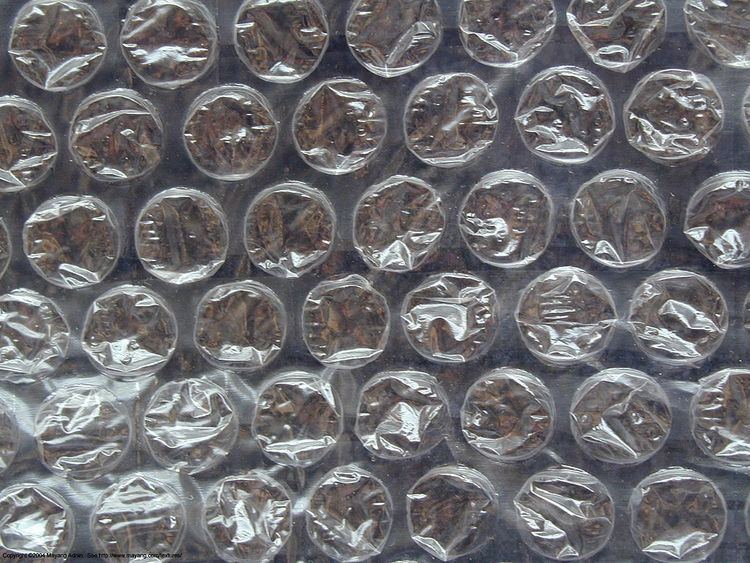 | ||
Bubble wrap is a pliable transparent plastic material used for packing fragile items. Regularly spaced, protruding air-filled hemispheres (bubbles) provide cushioning for fragile items.
Contents
"Bubble wrap" is a generic trademark owned by Sealed Air Corporation. In 1957 two inventors named Alfred Fielding and Marc Chavannes were attempting to create a three-dimensional plastic wallpaper. Although the idea was a failure, they found that what they did make could be used as packing material. Sealed Air Corp. was co-founded by Alfred Fielding in 1960.
The term is used generically for similar products, such as bubble pack, bubble paper, air bubble packing, bubble wrapping or aeroplast; Sealed Air denotes its product as a brand of "cushioning material".
Design
The bubbles that provide the cushioning for fragile or sensitive objects are generally available in different sizes, depending on the size of the object being packed, as well as the level of cushioning protection that is needed. Multiple layers might be needed to provide shock and vibration isolation. A single layer might be used just as a surface protective layer. Bubble wrap is used to form some types of mailing envelopes.
Bubble wrap is most often formed from polyethylene (LDPE) film with a shaped side bonded to a flat side to form air bubbles. Some types of bubble wrap have a lower permeation barrier film to allow longer useful life and resistance to loss of air in vacuums.
The bubbles can be as small as 6 millimeters (1/4 inch) in diameter, to as large as 26 millimeters (1 inch) or more, to provide added levels of shock absorption during transit. The most common bubble size is 1centimeter. In addition to the degree of protection available from the size of the air bubbles in the plastic, the plastic material itself can offer some forms of protection for the object in question. For example, when shipping sensitive electronic parts and components, a type of bubble wrap is used that employs an anti-static plastic that dissipates static charge, thereby protecting the sensitive electronic chips from static which can damage them.
The bubbles can be shaped in many ways, even heart-shaped, as the Italian company Torninova Corporation did in 1997.
Amusement
Because bubble wrap makes a satisfying popping sound when compressed and ruptured, it is often used as a source of amusement. Acknowledging this alternative use, some websites provide a virtual bubble wrap program which displays a sheet of bubble wrap that users may pop by clicking on the bubbles, while the Mugen Puchipuchi is a compact electronic toy simulating bubble wrap popping.
Bubble Wrap Appreciation Day is celebrated on the last Monday of January. The last Monday of January was designated as Bubble Wrap Appreciation Day after a radio station in Bloomington, Indiana received a shipment of microphones wrapped in bubble wrap, which, after being unwrapped and installed, inadvertently broadcast the sound of their wrappings being popped.
Sealed Air has controversially decided to create a new iBubble wrap, which will not be able to be popped.
